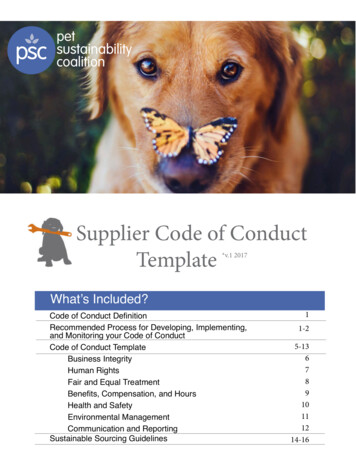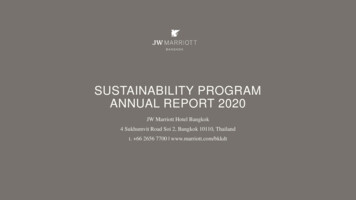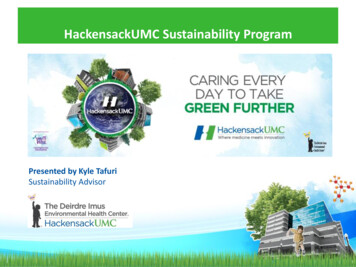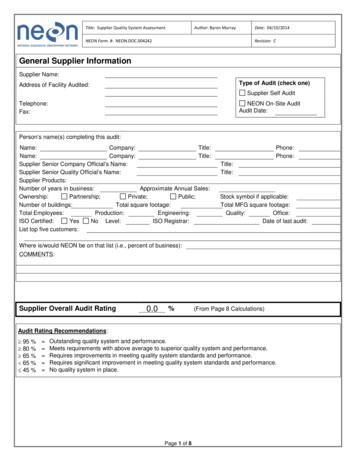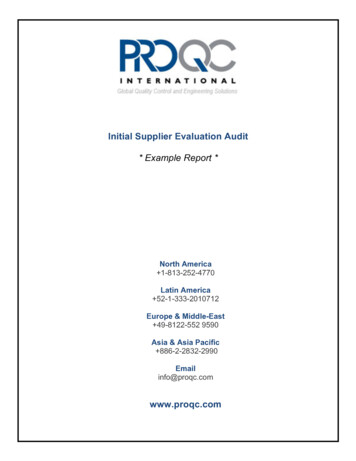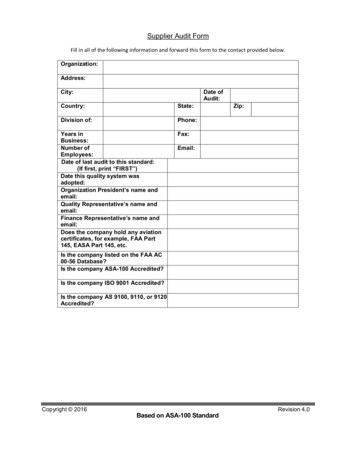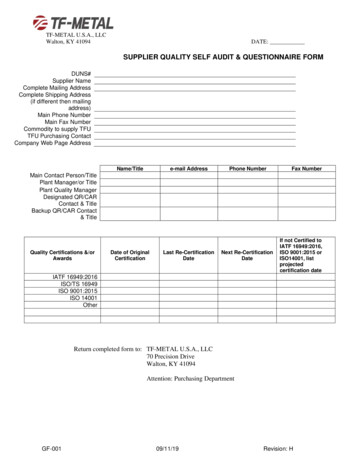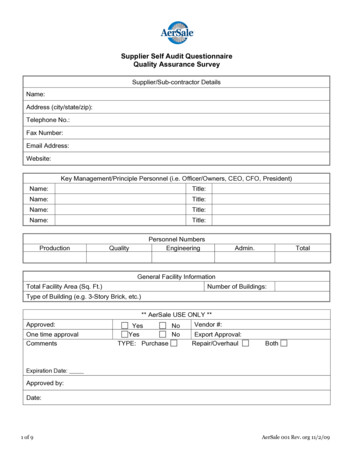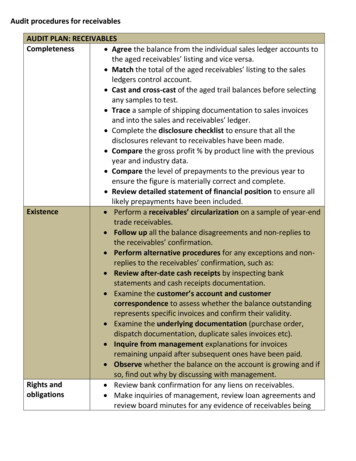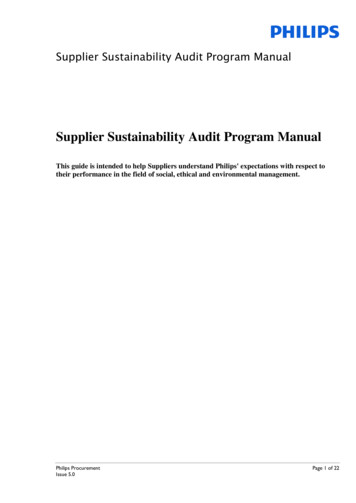
Transcription
Supplier Sustainability Audit Program ManualSupplier Sustainability Audit Program ManualThis guide is intended to help Suppliers understand Philips' expectations with respect totheir performance in the field of social, ethical and environmental management.Philips ProcurementIssue 5.0Page 1 of 22
ColophonThis Supplier Sustainability Audit Program Manual has been developed by Philips SupplierSustainability Management.We are continually looking for relevant examples from business practice to enhance the content ofthe manual and to ensure all relevant issues are covered.If you can provide us with such examples or if you need further information or have anycomments or questions about the content of this manual, please do not hesitate to contact Philips.To find out more about our audit programs and results visit our Sustainability website inklijke Philips N.V., Amsterdam, NetherlandsAll rights reserved. Reproduction in whole or in part is prohibitedwithout the written consent of the copyright owner.Version historySeptember 2007 Release 0.1 for internal use onlyNovember 2007 Release 1.0April 1, 2012 Release 2.0January 1, 2013 Release 3.0January 1, 2015 Release 4.0July 1, 2016 Release 5.0Philips ProcurementIssue 5.0Page 2 of 22
Dear Stakeholder,Philips is committed to improving the quality of people’s lives. This is what drives Philips in thedevelopment and manufacturing of our products. Promoting acceptable working conditions,environmentally responsible management and ethical behavior is all part and parcel of ourcommitment.These days our products are not just the result of a Philips effort. More and more, our productsare being created and manufactured in close cooperation with a wide range of business partners,both in the electronics industry and in other industries as well. If we are to deliver on ourcommitment to promote a sustainable future, we need our business partners to share ourcommitment, and not just in the development and manufacturing of products but also in the waythey conduct their business.One of the actions we have taken towards achieving this common goal is to become a member ofthe Electronics Industry Citizenship Coalition (EICC) in 2006. The EICC provides the electronicsindustry with a platform from which to develop standardized tools and processes, helping todevelop a uniform standard as well as to measure performance against this standard.Using this platform as a basis, Philips has created the Supplier Sustainability Program. Asexplained in this manual, this program defines what we expect of our Suppliers.In search of mutually beneficial relationships, we will award business to those Suppliers who arecommitted to living up to these expectations. As part of this joint approach, we will be there tosupport our Suppliers in cases where they need to improve their performance. Together we willstrive for continued improvement.This Supplier Sustainability Audit Program Manual aims to provide transparency to our Suppliers,business partners and other stakeholders about the Philips Supplier Sustainability Audit Program,its contents and the related tools, processes and procedures.I trust that this Supplier Sustainability Audit Program Manual will prove a useful tool in helpingyou to contribute to the creation of a sustainable Philips supply chain.I firmly believe that this is the only way forward, as it will improve the efficiency, productivityand product quality whilst also reducing waste-related costs, minimizing health & safety concerns,and improving employee satisfaction, etc. Moreover, in a world where sustainability isincreasingly becoming a condition of sale, a sustainable business approach is one way to ensurebusiness continuity and to create business opportunities.Marco BarenHead of the Philips Supplier SustainabilityPhilips ProcurementPhilipsPhilips ProcurementIssue 5.0Page 3 of 22
Table of contents1Introduction2Declaration of Commitment2.12.1.12.1.23Selective Monitoring3.13.24Getting togetherWhat can you do yourself?Supplier sustainability developmentDemonstration of ty risk profileSustainability risk criteriaKnowing What to Do4.14.24.35ContentThe Philips Supplier Sustainability DeclarationThe Philips List of Regulated Substances in Products, Product Packaging andTransport MaterialAudit content and processAudit selectionAudit preparationsAudit scheduling and paymentAnnounced versus unannounced auditsAudit teamAudit procedureAudit reportAudit frequencyResolving Non-Conformances6.16.26.36.4Resolution time per categoryCorrective Action Plan (CAP)Continued non-conformanceIssue-based resolution; cases of child laborReferencesPhilips ProcurementIssue 5.0Page 4 of 22
1 IntroductionPhilips' Suppliers and the Philips MissionPhilips is committed to improving the quality of people’s lives. This is what drives Philips in thedevelopment and manufacturing of our products. Promoting acceptable working conditions,environmentally responsible management and ethical behavior is all part and parcel of thiscommitment.Philips' commitment to responsible corporate citizenship and the pursuit of a sustainable future –in economic, social and environmental terms – is reflected in its mission as well as in the PhilipsGeneral Business Principles (GBP). The Philips GBP set out guiding principles on integrity andethics in business conduct, including those that help create a sustainable supply chain.In short, Philips pursues mutually beneficial relationships with its Suppliers and seeks to awardbusiness to those Suppliers who are committed to acting fairly and with integrity towards theirstakeholders, to observing the applicable rules of law and to supporting and respectinginternationally proclaimed human rights.The Supplier Sustainability Audit ProgramGiven our commitment, Philips aims to work with Suppliers and business partners who show asmuch dedication to improving people's quality of life as they do to improving the quality of theirproducts. A Supplier Sustainability Audit Program (‘Program’) has been put in place for thispurpose. The Program is based on Philips' expectations of Suppliers, as set out in following twodocuments:- Philips Supplier Sustainability Declaration (‘Declaration’) and- Philips List of Regulated Substances in Products, Product Packaging and Transport Material(‘RSL’)Both the Declaration and RSL constitute an integral part of our General Purchasing Agreements.The Declaration incorporates the Electronics Industry Code of Conduct (EICC Code), a codedeveloped within the electronics industry as convened in the Electronics Industry CitizenshipCoalition1. The Declaration contains an annex covering freedom of association and the right ofcollective bargaining in accordance with the relevant ILO Core Conventions. The Declarationwill be updated on a regular basis. For the latest version please visit our arationBuildunderstandingTraining andcapabilitybuildingRegulatedSubstance ListManageriskMonitor identifiedrisk suppliersRiskassessmentSelfassessmentAuditWork withstakeholdersResolving logueRepeat auditcycle every 3yearsThe Philips Supplier Sustainability Audit Program1For current member list visit: http://www.eiccoalition.org/about/members/Philips ProcurementIssue 5.0Page 5 of 22
2 Declaration of CommitmentPhilips requires every Supplier to share its commitment to promoting acceptable workingconditions, environmentally responsible management and ethical behavior. The basis for this islaid down in:- the Philips Supplier Sustainability Declaration (‘Declaration’), and- the Philips List of Regulated Substances in Products, Product Packaging and TransportMaterial (‘RSL’).Both the Declaration and the RSL will therefore constitute an integral part of any purchasingagreement between the Supplier and Philips, and Philips expects Suppliers to integrate the contentof both documents into their internal policies, processes and procedures, and to roll out both theDeclaration and the RSL to their next-tier Suppliers.2.1 Content2.1.1 The Philips Supplier Sustainability DeclarationThe Philips Supplier Sustainability Declaration ('Declaration') consists of five chapters and anAnnex.Chapter A formulates the human rights of workers. The labor standards comprise rules relating tofreely chosen employment, child labor avoidance, working hours, wages and benefits, humanetreatment, non-discrimination, and freedom of association. This latter aspect is elaborated in theAnnex to the Declaration, which sets out clearly employees' rights relating to freedom ofassociation and collective bargaining in accordance with the relevant ILO Core Conventions.Chapter B defines the workers’ right to a safe and healthy working environment. The health andsafety standards comprise rules regarding occupational safety, emergency preparedness,occupational injury and illness, industrial hygiene, physically demanding work, machinesafeguarding, sanitation, food, and housing.Chapter C reflects the environmental responsibility of EICC member companies. Theenvironmental standards consist of rules relating to environmental permits and reporting, pollutionprevention and resource reduction, hazardous substances, wastewater and solid waste, airemissions, and product content restrictions.Chapter D defines the standards of ethics that are required to meet social responsibilities,including rules relating to business integrity, no improper advantage, disclosure of information,intellectual property, fair business, advertising and competition, protection of identity, responsiblesourcing of minerals, privacy, and non-retaliation.Chapter E imposes upon Suppliers a management system designed to ensure (a) conformancewith the applicable laws, regulations and customer requirements relating to the participant’soperations and products; (b) conformance with the Declaration; and (c) identification andmitigation of operational risks related to the Declaration. It also aims to facilitate continualimprovement. The management system must contain the following elements: companycommitment, management accountability and responsibility, legal and customer requirements,risk assessment and risk management, improvement objectives, training, communication, workerPhilips ProcurementIssue 5.0Page 6 of 22
feedback and participation, audits and assessments, corrective action process, documentation andrecords, supplier responsibility.2.1.2 The Philips List of Regulated Substances in Products, Product Packaging andTransport MaterialAs part of Philips' commitment to health, safety and the environment, all products or parts,product packaging and transport material delivered to Philips as well as certain definedmanufacturing processes that are used to make Philips parts must comply with all applicablerequirements in the Philips List of Regulated Substances in Products, Product Packaging andTransport Material (RSL). The RSL contains minimum requirements relating to: federal, state, county or municipal laws, regulations, ordinances or codes, andPhilips' own requirements.The RSL constitutes an integral part of the General Purchasing Agreement.The RSL is updated regularly so as to ensure alignment with regulatory and industrydevelopments. Compliance to the RSL is monitored in a tool called ‘BOMcheck’. Philips and anumber of other large electronics companies have developed BOMcheck as an industry-wideplatform that standardizes the way in which companies collect chemical composition informationfrom their Suppliers. Philips requires Suppliers to provide declarations of compliance with theRSL via BOMcheck. BOMcheck can be found at http://www.bomcheck.net/The latest version of the RSL is available on the Philips website.3 Selective MonitoringSuppliers are expected to implement internal controls to ensure they are able to live up to theircommitment of compliance. The type of support Philips provides and the monitoring Philipscarries out will depend on the risk profile of the Supplier.3.1 Sustainability risk profileThe Supplier’s risk profile is determined by criteria relating to:- Country in which production sites are located- Substances used in the product and manufacturing process- Commercial interests: Philips' spend with Supplier- Incidents reported to Philips directly or indirectly, e.g. via the media- Type of product or service delivered to Philips3.2 Sustainability risk criteriaCountry in which production sites are locatedAll countries that fall into the ‘extreme’ or ‘high’ risk category in the Maplecroft Human RightsRisk Index and the Maplecroft ‘Legal and Regulatory Environment Risk Atlas’ are deemed riskcountries. Based on Philips' Supplier base distribution and purchasing value, Philips determines aPhilips ProcurementIssue 5.0Page 7 of 22
number of risk countries for its audit program. This list of risk countries will be reviewedregularly and, where necessary, changes will be made. The latest list of risk countries can befound on the following Philips geSubstances used in the product and manufacturing processThe use of hazardous substances or processes, e.g. mercury, volatile organic solvents, metalplating, acid washing, or radiation sources, may lead to a Supplier being classified as a high-riskSupplier. Such Suppliers are categorized as “high-risk” Suppliers in our database.For IMS Suppliers: there are specific criteria for identifying high risk Suppliers, which is differentfrom BOM Suppliers. IMS Suppliers with yearly spend between 200 K – 1 M Euro under highrisk CLOG are high risk Suppliers.Other suppliers located in risk countries are identified as high risk by business.Commercial interests: Philips' spend with SupplierFor monitoring purp
01.04.2012 · The Supplier Sustainability Audit Program Given our commitment, Philips aims to work with Suppliers and business partners who show as much dedication to improving people's quality of life as they do to improving the quality of their products. A Supplier Sustainability Audit Program (‘Program’) has been put in place for this purpose. The Program is based on Philips' expectations of Suppliers, as set
